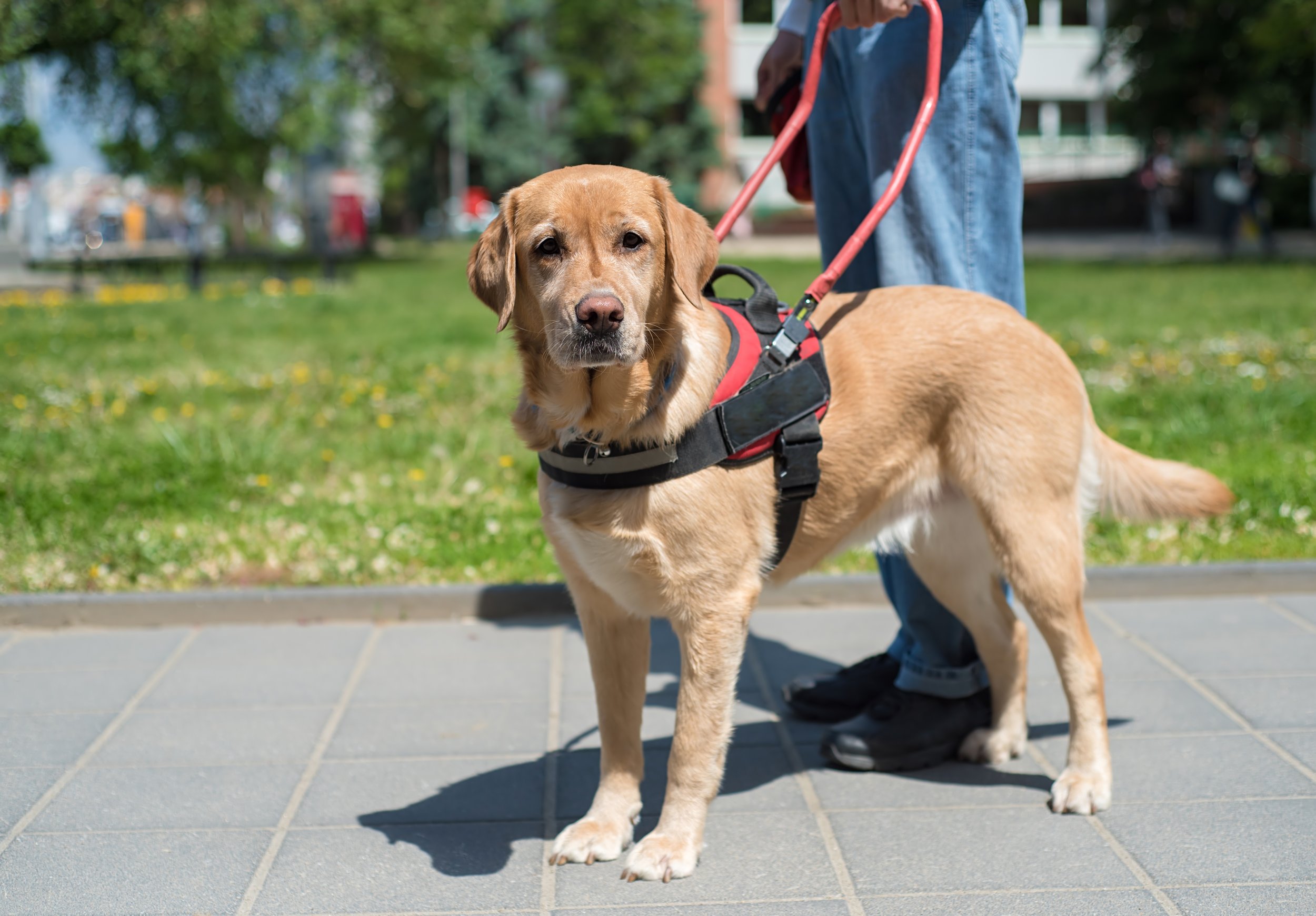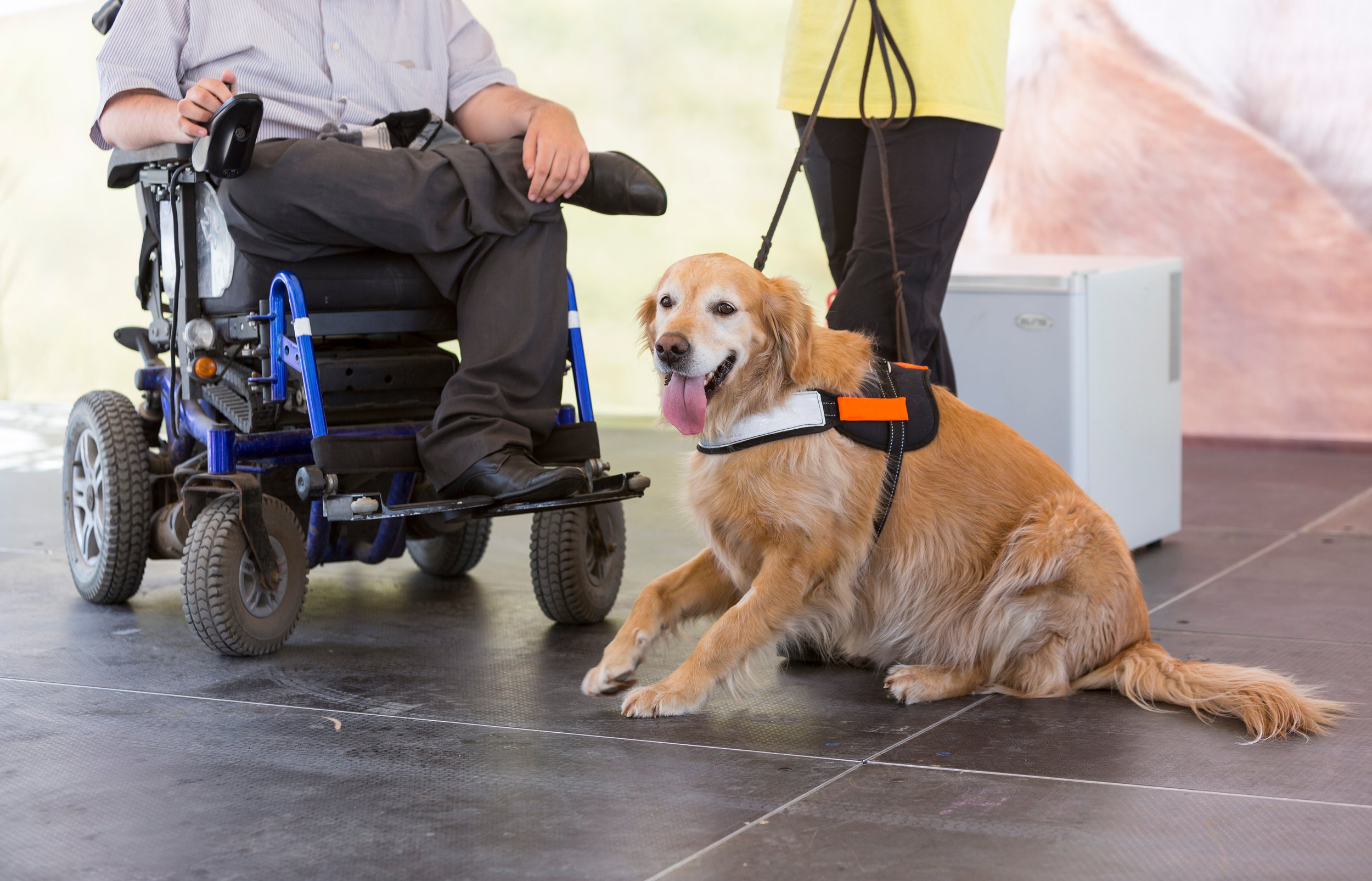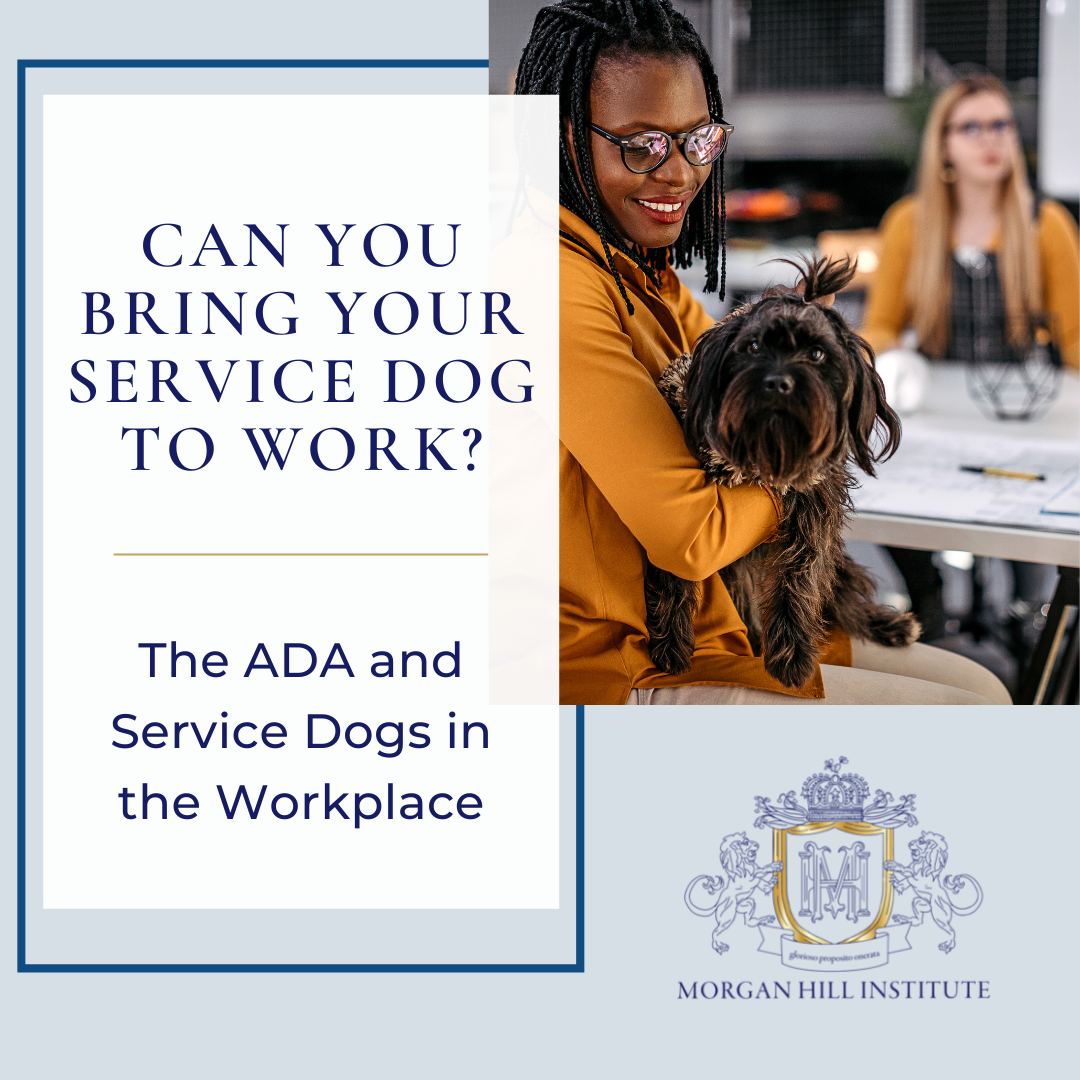Service Dogs 101 | Everything You Need to Know About Service Dogs
What is a service dog?
The Americans with Disabilities Act (ADA) defines a service dog as a dog that has been individually trained to do work or perform tasks for an individual with a disability; the task(s) performed by the dog must be directly related to the person’s disability. The types of service dogs are constantly expanding as people’s needs evolve. Service dogs provide support for individuals with physical, neurological or mental health needs.
What makes a good service dog? what breeds can be a service dog?
The most common breeds for service dogs in the United States are Labradors, Golden Retrievers, and German Shepherds, but any breed can be used. For individuals with mobility issues, it may be more appropriate to use a large frame dog that can offer physical support, such as a Bernese Mountain Dog.
Effective service dogs share the following characteristics:
Calm temperament: An effective service dog shouldn’t cause disturbances in public or be easily startled by events in the surrounding area.
Energetic: The dog will need to work all day to support the handler. It should have the energy and stamina to keep up with potentially long days.
Enjoys being around people: The handler will most likely use the dog in public and social settings. The dog should be comfortable being around a variety of people and not display fear or aversion towards genders, ethnicities, or physical differences.
Tolerates being around other animals: The service dog will encounter other animals as a regular part of its working life. It should be able to ignore other working dogs, squirrels, and pets to stay focused on its handler. It shouldn’t be uncomfortable or act aggressively towards other animals.
Strong desire to please: The need to please the handler by doing what is expected will make training easier as the dog learns many complex tasks.
Able to focus/ignore distractions: The dog will experience a wide variety of settings and people. It will need to maintain focus on the handler and ignore distractions in the environment and well-meaning individuals who may try to pet it or offer a treat.
Relaxes in all environments: Dogs typically sleep 12 – 14 hours a day. A service dog needs to be able to relax in a variety of environments during the working day, such as during office meetings or a noisy manufacturing building.
Intelligence: Intelligence is a key characteristic of service dogs. The training is extensive and dogs who are quick learners will do best. Once trained, the dog will be presented with new and unique challenges when working. It may need to do its job while surrounded by strangers in a crisis situation, perform several complicated multi-steps tasks in a row, and prioritize tasks for the handler’s safety and well-being if the handler is in danger.
Loving demeanor: Forming a bond with the handler is critical for a successful working partnership. The service dog is not just a tool to be used to compensate for an impairment. It is a living, breathing creature with emotional needs who will crave the affection of its handler. This devotion will be irreplaceable in the working partnership.
How much does a service dog cost?
Most service dogs will cost upwards of $20,000 depending on the amount of training needed. Most training occurs during the first two years of the dog’s life. It begins with basic obedience and progresses to the specific skills a handler will need.
does health insurance cover service dogs for disabilities?
The majority of health insurance carriers do not cover the cost of obtaining a service dog. Individuals may be able to use Healthcare Reimbursement Accounts or Healthcare Spending Accounts to cover the cost of the service animal. The Internal Revenue System (IRS) does include the cost of a service dog as a valid medical expense deduction. A tax specialist should be consulted before making assumptions about reimbursements or tax deductions.
The Department of Veterans Affairs may provide assistance for qualified veterans. They may assist with travel to initially pick up the dog, replace worn-out equipment such as harnesses, or reimburse all or some of the veterinary costs for a service dog.. Veterans should contact their local veteran’s medical center and ask for the prosthetics department to learn more.
Types of Service Dogs
Service dogs can serve people with a wide range of disabilities, both physical and mental. Some dogs provide physical assistance, while other service dogs (alert dogs) can actually signal an emergency health condition is about to occur.
Visual Assistance Dogs (Guide Dogs)
A guide dog is a mobility aid that helps people with visual impairments to reach destinations with independence and greater speed. The dog is able to help the handler identify barriers (tripping hazards), alert them when a change in stepping technique is needed (stairs), and lead them around moving obstacles (other people). Guide dogs are most often Labrador or Golden Retrievers but may be any breed. The guide dog does not act independently and relies upon the handler for decision-making and guidance. If a student needs to walk across campus for a class, the dog does not innately know which building to take the handler to. The handler must know the location of the building and provide guidance to the dog on which direction to go. The dog then selects the safest path.
Hearing Assistance Dogs
Hearing assistance dogs are similar to guide dogs. A hearing assistance dog alerts their handler to noises in the environment including alarms, doorbells, or crying babies. Typically, the dog has a trained behavior in response to the noise such as putting a paw on the handler.
Virtually any breed can be trained as a hearing dog due to their very sensitive hearing. Some dog breeds can hear sounds four times farther away than a human can. Their hearing range includes sounds both higher and lower than what a human can hear. A dog’s hearing will vary by breed and age, but the average range is 67 Hz to 45,000 Hz. Human hearing decreases with age, with a typical range of 20 Hz to 20,000 Hz.
Mobility Assistance Dogs
Mobility assistance dogs help individuals who have strength and/or balance issues by bringing them objects, pressing buttons, pulling a wheelchair up a ramp, or bracing the individual as they stand. Generally large sized breeds are most suited to being a mobility assistance dog, such as Labrador retrievers, Golden retrievers, Poodles, Newfoundlands, Bernese Mountain Dogs, Great Danes, and mastiffs.
These dogs may also be called wheelchair assistance dogs because the handler may use a wheelchair part or all of the time.
Mobility assistance dogs may also serve as a brace for the handler, either to prevent the handler from falling down or by providing a steady brace so the handler get up. They can also be trained to summon help if the handler falls or has a seizure,
Mobility assistance dogs are most helpful for individuals diagnosed with arthritis, brain injury, cerebral palsy, coordination problems, fibromyalgia, multiple sclerosis, muscular dystrophy, spina bifida, spinal cord injury or vertigo. The are trained to provide support for handlers who have difficulty with balancing, standing, remaining stable, and moving around. They are also helpful for people whose symptoms include debilitating pain, dizziness, or severe fatigue.
Common tasks include providing stability on stairs, support when dressing, retrieving a dropped object, pressing buttons for elevators or crosswalks, opening and closing doors, drawers, and closets, turning lights on or off, and carrying small bags or objects.
They can also be trained for highly specialized tasks for the handler. For example, a mobility service dog may be trained to burrow under the handler’s legs to elevate blood pressure if the handler passes out. They can also be taught to put the handler on their side or into a recovery position. If the handler collapses in an unsafe place, the mobility dog is trained to drag the person (or the wheelchair) to a safe spot. The dog may also bark at strangers and attempt to get them to follow the dog back to the unconscious handler.
Unlike other service dogs, a mobility dog will likely be wearing a specific harness or vest to aid the handler with mobility. The harness is fitted to the individual dog to disperse the pressure of brace safely along the dog’s body. The harness may also allow the dog to pull a wheelchair, small cart, or oxygen tank.
Psychiatric Service Dogs
Psychiatric service dogs are trained to assist handlers with impairments related to brain chemistry malfunction. They can assist with a variety of diagnoses but are most commonly used for individuals diagnosed with mood disorders such as anxiety, depression, or post-traumatic stress disorder. Although not technically psychiatric conditions, people with Fetal Alcohol Syndrome and those on the autism spectrum can also have their social-emotional needs met by a service dog. The tasks psychiatric service dogs perform typically fall into four categories:
Assistance during a medical crisis
Retrieve medication
Bring a beverage for swallowing medication
Bring the phone during a crisis
Opening the door for emergency services
Get a family member for assistance
Assistance during treatment
Provide medication reminder at specific time of day
Assist handler with waking up to an alarm clock or during an emergency alert such as a smoke detector
Assistance coping with emotional overload
Provide tactile stimulation
Provide pressure massage
Turn lights on/off
Nudge handler during fear paralysis or disassociation spell
Security enhancement tasks
Scanning room or home for invaders
Turning lights on before the handler enters the room
Note: Emotional support animals and therapy dogs are not psychiatric service dogs. They are not covered by the ADA and do not have rights to public access. Behaviors that dogs naturally do such as snuggling a depressed person or enticing an upset person to play with a tennis ball or tug toy are not recognized as trained or specialize tasks under the ADA to meet the standard for a service dog.
Medical Alert Dogs
Dogs have significantly better senses of smell than humans do. Humans typically have around 6 million olfactory receptors in the nose; a dog may possess up to 300 million. The part of the dog’s brain that is devote to processing smell is about 40 times larger than that of humans. Their incredible sense of smell is what has made dogs invaluable partners for detecting drugs or bombs, tracking suspects for law enforcement, and finding dead bodies.
Several types of medical alert dogs are rooted in the dog’s ability to smell changes in the handler. This includes changes in blood sugar and hormone levels. Some dog’s sense of smell also alerts them to changes in the handler’s mood, such as elevated fear or anxiety.
Dogs cannot be initially trained to detect the medical changes in a human. They have to show an aptitude for the skill and be trained to perform a specific response when the stimulus is detected (such as a change in the handler’s breath). Very few dogs have this ability. A dog who is able to detect a change in the smell of the handler’s breath and alert to a possible drop in blood sugar levels may not be able to detect the smell of cervical cancer cells.
Individuals should not expect a family pet to be able to detect these critical biochemical changes and alert the handlers. It is the rare dog who shows aptitude for medical alert services and they require extensive training to ensure they respond correctly 100% of the time.
Diabetic Alert Dogs
Diabetic alert dogs are specifically trained to alert the handler to low or high blood sugar levels before they become dangers (hypoglycemia and hyperglycemia). The alert triggers the handler to check blood sugar levels and take the appropriate medication or action. The dog may further get a family member or signal for help if the individual loses consciousness. These dogs may also be known as Blood Sugar Alert Dogs. The most commonly used breeds are Golden retrievers, Labrador retrievers, mixed sporting dog breeds, and poodles.
Diabetic alert dogs do not “smell changes in the blood” of their handlers. Instead, they respond changes in the scent of the handler’s breath caused by chemical changes in blood sugar levels. The scent change caused during hyperglycemic or hypoglycemic events is imperceivable by humans.
The diabetic alert dog will be trained to provide a specific warning to the handler when it detects a change in blood sugar levels. Typically, the dog stares at the handler, touches the handler with its nose, or puts a paw on the handler. The dog can also be trained to retrieve a bag of medical equipment, alert other members of the household, or bring a phone to the handler. If the dwelling has a built-in emergency alert system, the dog can be trained to press a button that contacts emergency services. The dog may also be trained to greet emergency personnel at the door and guide them to the handler or may be trained to bark when it hears emergency response sirens until the workers locate the dog and handler.
Seizure Alert Dogs
There is considerable debate about seizure alert dogs. In theory, they have the natural ability to alert to an impending seizure by detecting a change in the handler’s scent. A small number of dogs have been shown to do this, but it does not appear to be a skill a dog can be trained for. With that in mind, there are dogs who are able to reliably alert their handlers to an impending seizure with varying lead times of up to 45 minutes. The handler is then able to take precautions such as laying down or contacting emergency services. Having time to prepare for the seizure reduces the number of falls and injuries resulting from falling.
Seizure Response/Assist Dog
Seizure response/assist dogs can be more reliably trained than seizure alert dogs. As they get to know their handlers, they may be able to detect small changes that do alert to an impending seizure, but the handler must notice the alerting behavior and interpret it as an alert.
Most seizure dogs are trained to assist the handler during and after a seizure, not to predict the seizure itself. These dogs provide help to handlers having an epileptic seizure by barking for help or pressing an alarm system to request medical assistance. They can also bring medicine or a cell phone to the person as the seizure ends. During the seizure the dog may be trained to position itself between the handler and any dangerous objects, such as sharp edges or stairs, to prevent additional injury.
Cardiac Alert Dogs
Cardiac alert dogs can be a wonderful asset to people with heart defects or disorders. These dogs are able to detect impending severe drops in blood pressure which have the potential to cause a loss of consciousness. Early detection allows the handler to seek medical attention or get into a safe position before passing out. Like other service dogs they can also be trained to get assistance when the handler is non-responsive.
The excellent hearing of dogs allows them to easily hear the sound of the handler’s heartbeat. If they detect changes or abnormalities in the rhythm, they will alert the handler, who can then determine what the appropriate next step is.
Oncology Alert Dogs
Cancer cells produce a very specific odor. Dogs have been trained to detect breast, cervical, colorectal, hung, stomach, liver, ovarian, prostate, skin, and thyroid cancers. They sniff various body substances to detect the presence of the cancer cells. Oncology alert dogs can alert to changes in several bodily areas, including:
Skin
Breath
Urine
Feces
Sweat
Blood
Allergy Detection Dogs (Anaphylaxis Service Dogs or Anaphylaxis Prevention Dogs)
Allergy detection dogs are trained using similar methods for training police and military dogs. A reward-based system is used to reward the dog when it alerts to a specific smell. If it alerts to the wrong smell, there is no reward. The dog must learn to ignore other smells and only focus on the targeted smell.
Allergy detection dogs sniff and alert to the odors of specific foods like peanuts, shellfish, or gluten. They are increasingly popular for children with severe allergies who may not be able to identify a potential hazard on their own. Even trace amounts of a triggering food can lead to an emergency requiring immediate medical intervention.
Anaphylaxis is the most severe allergic reaction. It causes the body to release chemicals triggering drops in blood pressure. The airways narrow and breathing becomes difficult or impossible. Prompt medical treatment and intervention is needed to save the individual’s life.
Individuals whose allergic reactions are this severe must maintain constant vigilance about their environment to minimize or avoid exposure to the triggering allergen. An allergy alert dog can allow these individuals greater confidence when interacting with others or going to places. Before the handler is given a food item, medication, or hygiene product the allergy alert dog sniffs the item. If the triggering scent is not present the dog will ignore the item. If the dog does detect the triggering scent it will alert the handler to avoid that item, typically by placing a paw on the handler.
Allergy detection dogs also monitor the environment for changes that could be harmful to the handler. This includes heating/cooling systems turning on or off or an open window allowing tree, grass or flower dander into the room. It’s possible that the open window may not be in the same room as the handler, but the air system in the building may transport the allergens from the open window throughout the building.
Summary
For people living with a disability, service dogs can provide immeasurable improvements to their daily lives. No matter what the age or disability, there are service dogs that can be trained to provide greater independence and safety, allowing people to participate more fully in life.
disability rights and service dog expert melissa kaekel
Morgan Hill Institute’s Melissa Kaekel is an expert on disability rights in the workplace and service dogs. Interested in having Melissa consult for your organization or speak to your group, be a guest on your podcast, or be an expert source for a press piece? Learn more about consulting and speaking services here.











